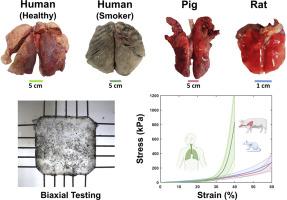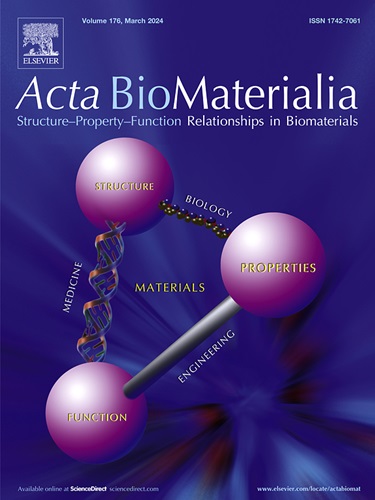内脏胸膜力学:内脏胸膜力学:人、猪和大鼠肺材料特性的表征
IF 9.4
1区 医学
Q1 ENGINEERING, BIOMEDICAL
引用次数: 0
摘要
肺漏气是肺部手术中最常见的并发症之一。肺部密封剂应用于器官表面,需要与内脏胸膜同步伸展,内脏胸膜是包裹肺实质组织的一层组织。这些粘合剂通常在猪肺和大鼠肺这两种动物身上进行测试,但却应用于人类肺部。然而,由于人类肺脏胸膜的力学结构尚不清楚,因此此类经动物测试的密封剂无法应用于临床,而猪肺和大鼠肺脏胸膜与人类组织相比的差异也是需要解决的问题。在这里,我们首次量化了符合移植条件的健康人肺和吸烟者肺内脏胸膜的双轴平面拉伸力学,并进一步将其材料行为与猪肺和大鼠肺内脏胸膜进行了比较。分析和比较了组间和组内的初始和最终刚度模量、最大应力、低应变到高应变的转变以及应力松弛,并进一步考虑了区域和方向依赖性。所有物种的内脏胸膜组织都表现为各向同性,猪和人的内脏胸膜表现出区域异质性(即上叶与下叶的差异)。我们发现,与人类内脏胸膜相比,猪内脏胸膜表现出相似的初始刚度模量和区域趋势,这表明猪组织可作为肺密封剂测试的可行候选动物模型。这些稀缺组织的结果和力学特征有助于未来仿生肺密封剂的开发,以改进外科应用。意义声明:手术用肺密封剂必须与下层组织同步变形,并随着每次呼吸而变形,以最大限度地减少术后漏气,而漏气仍是肺部介入手术最常见的并发症。这些粘合剂通常在猪肺和大鼠肺上进行测试,但并不适用于人类;然而,人类肺脏胸膜的材料特性之前尚未得到研究。本文首次研究了人体内脏胸膜组织的力学特性,进一步对比了很少获得的健康人和吸烟者的捐赠肺,并将双轴平面材料特性与肺密封剂开发中经常使用的动物模型进行了比较。这种基本的材料表征解决了生物仿生密封剂发展过程中的主要障碍,并评估了动物模型实验在临床应用中的可转化性。本文章由计算机程序翻译,如有差异,请以英文原文为准。

Visceral pleura mechanics: Characterization of human, pig, and rat lung material properties
Pulmonary air leaks are amongst the most common complications in lung surgery. Lung sealants are applied to the organ surface and need to synchronously stretch with the visceral pleura, the layer of tissue which encompasses the lung parenchymal tissue. These adhesives are commonly tested on pig and rat lungs, but applied to human lungs. However, the unknown mechanics of human lung visceral pleura undermines the clinical translatability of such animal-tested sealants and the absence of how pig and rat lung visceral pleura compare to human tissues is necessary to address. Here we quantify the biaxial planar tensile mechanics of visceral pleura from healthy transplant-eligible and smoker human lungs for the first time, and further compare the material behaviors to pig and rat lung visceral pleura. Initial and final stiffness moduli, maximum stress, low-to-high strain transition, and stress relaxation are analyzed and compared between and within groups, further considering regional and directional dependencies. Visceral pleura tissue from all species behave isotropically, and pig and human visceral pleura exhibits regional heterogeneity (i.e. upper versus lower lobe differences). We find that pig visceral pleura exhibits similar initial stiffness moduli and regional trends compared to human visceral pleura, suggesting pig tissue may serve as a viable animal model candidate for lung sealant testing. The outcomes and mechanical characterization of these scarce tissues enables future development of biomimetic lung sealants for improved surgical applications.
Statement of significance
Surgical lung sealants must synchronously deform with the underlying tissue and with each breath to minimize post-operative air leaks, which remain the most frequent complications of pulmonary intervention. These adhesives are often tested on pig and rat lungs, but applied to humans; however, the material properties of human lung visceral pleura were previously unexplored. Here, for the first time, the mechanics of human visceral pleura tissue are investigated, further contrasting rarely acquired donated lungs from healthy and smoking individuals, and additionally, comparing biaxial planar material characterizations to animal models often employed for pulmonary sealant development. This fundamental material characterization addresses key hindrances in the advancement of biomimetic sealants and evaluates the translatability of animal model experiments for clinical applications.
求助全文
通过发布文献求助,成功后即可免费获取论文全文。
去求助
来源期刊

Acta Biomaterialia
工程技术-材料科学:生物材料
CiteScore
16.80
自引率
3.10%
发文量
776
审稿时长
30 days
期刊介绍:
Acta Biomaterialia is a monthly peer-reviewed scientific journal published by Elsevier. The journal was established in January 2005. The editor-in-chief is W.R. Wagner (University of Pittsburgh). The journal covers research in biomaterials science, including the interrelationship of biomaterial structure and function from macroscale to nanoscale. Topical coverage includes biomedical and biocompatible materials.
 求助内容:
求助内容: 应助结果提醒方式:
应助结果提醒方式:


